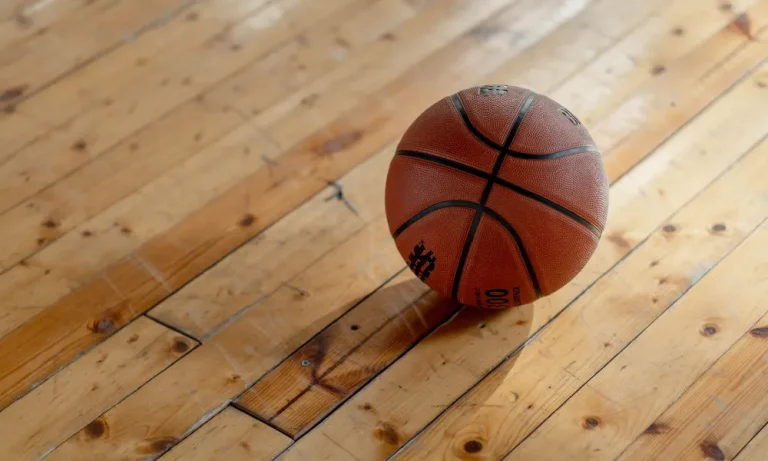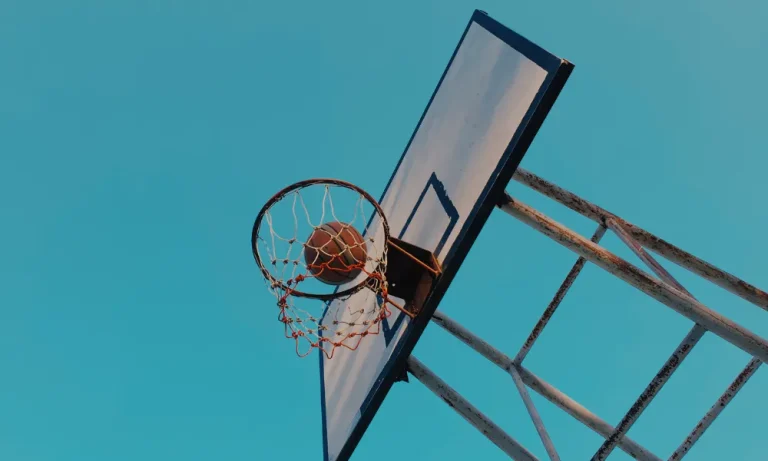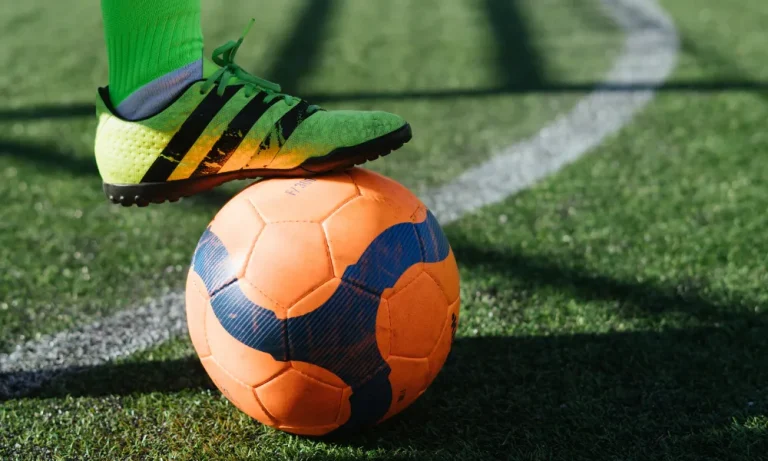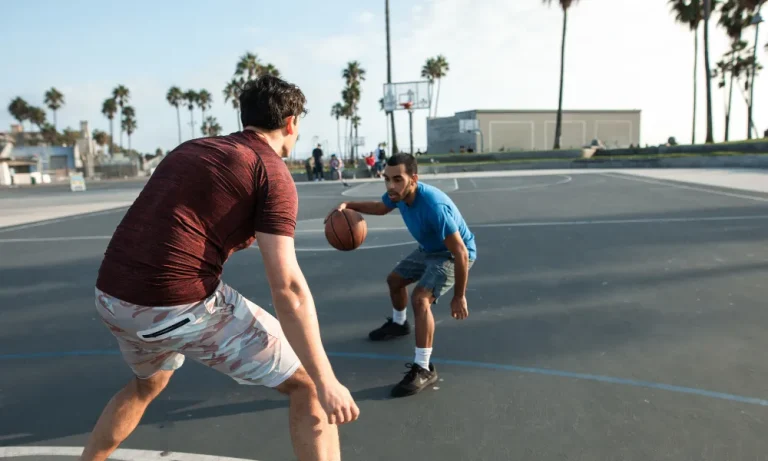Basketball vs. Volleyball: Gameplay, Equipment, Team Dynamics
Looking for some sports action but can’t decide between basketball and volleyball? Don’t worry, we’ve got you covered! In this engaging blog post, we’ll dive into the world of these two thrilling sports, exploring their origins, rules, gameplay, and even the fitness benefits they offer. So grab a seat and let’s unravel the secrets of basketball and volleyball!
Gameplay and Rules
When it comes to basketball and volleyball, understanding the gameplay and rules is essential to fully enjoy these sports.
Basketball: Dribbling, Shooting, and Passing
Basketball is a fast-paced game that requires agility, coordination, and teamwork. The objective is simple: score points by shooting the ball into the opponent’s hoop. To achieve this, players engage in various skills and techniques.
Dribbling is a fundamental skill in basketball, where players bounce the ball with one hand while moving around the court. It allows players to maintain control and maneuver past defenders.
Shooting is another crucial aspect, where players aim to throw the ball into the hoop from various distances. Passing involves transferring the ball to teammates to create scoring opportunities.
In terms of rules, basketball has specific regulations to ensure fair play. Fouls and violations, such as charging, blocking, or traveling, are called by referees to maintain order. The game is played on a rectangular court with two teams of five players each. The court is divided into two halves with a hoop at each end.
Volleyball: Serving, Setting, and Spiking
Volleyball, on the other hand, is a dynamic sport played with two teams on a court divided by a net. The objective is to keep the ball in play and send it over the net to the opponent’s side while preventing it from hitting the ground on your side.
Serving is the starting point of each rally, where a player hits the ball over the net to initiate play. Setting involves using fingertips to redirect the ball to a teammate who then attacks it, known as spiking, by forcefully hitting it toward the opponent’s court.
To ensure fair play, volleyball has its own set of rules. Players rotate positions after each point, ensuring equal opportunities for each player. Violations such as touching the net, carrying the ball, or stepping over the boundary lines result in penalties.
Understanding the court layout is crucial in volleyball. The court is rectangular, divided into two equal halves by a net. Each team has six players, with specific positions such as setters, hitters, and libero.
Equipment and Attire
When it comes to sports, having the right equipment and attire is essential for both performance and safety.
Basketball: Balls, Nets, and Shoes
Basketball requires a few key pieces of equipment. The most important is the basketball itself, which is typically made of leather or synthetic materials.
The size and weight of the ball vary depending on the age and gender of the players. The ball’s design allows for better grip and control during dribbling, passing, and shooting.
Another vital piece of equipment is the hoop and net. The hoop is a metal ring attached to a backboard, and the net is hung from the rim. The height of the hoop is standardized for different levels of play.
In terms of attire, basketball players wear comfortable and breathable clothing. This usually includes a jersey or shirt and shorts that allow for freedom of movement. Players also wear supportive basketball shoes that provide stability and cushioning to minimize the risk of injuries.
Volleyball: Balls, Nets, and Uniforms
Volleyball also has specific equipment requirements. The volleyball itself is made of synthetic leather or rubber, with a distinctive panel design that enhances grip and control. The size and weight of the ball are regulated to ensure consistency in play.
The net in volleyball is crucial, as it separates the two teams and determines the height at which the ball must be played. The net is usually made of nylon and is set at a specific height for men’s and women’s competitions.
In terms of attire, volleyball players wear specialized uniforms. These typically consist of a jersey or shirt and shorts for both men and women. The uniforms are designed to be lightweight, allowing for ease of movement, and often feature moisture-wicking materials to keep players cool and comfortable during intense matches.
Physical Demands and Fitness Benefits
Engaging in sports is not only fun but also offers numerous physical benefits. Let’s compare the physical demands of basketball and volleyball and explore the fitness benefits that these sports provide.
Basketball vs. Volleyball: Physical Demands
Both basketball and volleyball require athletes to possess certain physical attributes. Basketball demands a combination of speed, agility, endurance, and strength. Players constantly move around the court, sprinting, jumping, and changing directions rapidly.
The physical demands in basketball are high, as players need to perform quick bursts of energy throughout the game.
On the other hand, volleyball focuses on explosive movements and quick reflexes. Players must jump to block or spike the ball, dive to make saves, and change direction swiftly. The physical demands in volleyball require athletes to have good coordination, balance, and agility.
Fitness Benefits: Cardiovascular Health, Agility, and Coordination
Both basketball and volleyball offer numerous fitness benefits. Firstly, these sports provide excellent cardiovascular exercise. The constant movement and intensity of the games increase heart rate, improving cardiovascular health and lung capacity.
Secondly, basketball and volleyball enhance agility and coordination. The quick movements, changes in direction, and hand-eye coordination required in these sports improve overall agility and motor skills.
Furthermore, these sports contribute to muscular strength and endurance. Jumping, running, and repetitive movements in basketball and volleyball engage various muscle groups, resulting in improved strength and endurance over time.
Lastly, participating in basketball and volleyball promotes social interaction and teamwork. These sports require effective communication, cooperation, and trust among teammates, fostering valuable life skills.
Team Dynamics and Strategy
Team dynamics and strategy play a crucial role in the success of any team sport. Let’s delve into the team dynamics of basketball and volleyball, exploring offensive and defensive strategies, as well as the importance of teamwork and communication in each sport.
Basketball: Offense, Defense, and Teamwork
In basketball, teams employ various offensive strategies to score points. This includes setting screens, passing the ball, and executing plays to create open shots.
Offensive players must work together, utilizing their individual skills and communication to outmaneuver the opposing defense.
On the defensive end, basketball teams use strategies like man-to-man defense or zone defense. Man-to-man defense involves each player guarding a specific opponent, while zone defense assigns players to cover specific areas on the court.
Effective defensive strategies require coordination, communication, and quick decision-making.
Teamwork and communication are integral to success in basketball. Players must trust and rely on each other, passing the ball, setting screens, and working collectively to create scoring opportunities. Effective communication ensures everyone is on the same page, facilitating the seamless execution of offensive and defensive strategies.
Volleyball: Offense, Defense, and Teamwork
Volleyball also relies heavily on teamwork and strategy. Offensive strategies in volleyball involve setting up plays to create opportunities for spiking the ball, using precise timing and coordination.
Players communicate through hand signals and verbal cues to orchestrate effective offensive attacks.
On the defensive side, volleyball teams employ strategies like blocking and digging to prevent the opponent’s attacks from scoring. Blocking involves players jumping to intercept the ball at the net, while digging refers to players making quick saves to keep the ball in play.
These defensive strategies require synchronized movement and communication among teammates.
Just like in basketball, teamwork, and communication are crucial in volleyball. Players must work together to set up plays, anticipate each other’s movements, and cover gaps on the court.
Effective communication ensures that everyone is aware of their roles and responsibilities, leading to the successful execution of offensive and defensive strategies.
Popularity and Global Reach
Sports have the power to transcend borders and bring people together. Let’s compare the popularity of basketball and volleyball worldwide and explore their global reach through professional leagues and international competitions.
Popularity: Basketball vs. Volleyball
Basketball enjoys immense popularity worldwide, with a massive fan base and widespread participation. The sport’s fast-paced nature, high-flying dunks, and thrilling gameplay have contributed to its global appeal.
Basketball is particularly popular in North America, Europe, and Asia, with the National Basketball Association (NBA) being the most prestigious professional league.
Volleyball, while not as globally dominant as basketball, is still widely loved and played. It boasts a significant following in countries like Brazil, Italy, and Russia, where it is a popular spectator sport.
The FIVB Volleyball World Championships and the Olympic Games are highly anticipated international events that showcase the sport’s global reach.
Global Reach: Professional Leagues and International Competitions
Basketball’s global reach is evident through the presence of professional leagues in various countries. The NBA, as mentioned earlier, is the pinnacle of professional basketball, attracting top talent from around the world.
Additionally, other countries have their own professional leagues, such as the EuroLeague in Europe and the Chinese Basketball Association (CBA) in China.
Volleyball also boasts professional leagues in different regions, although their popularity may vary.
The Italian Serie A1, the Brazilian Superliga, and the Russian Super League are among the most prestigious volleyball leagues. These leagues gather talented players from around the world, contributing to the international appeal of the sport.
International competitions further highlight the global reach of both sports. Basketball’s FIBA Basketball World Cup and the Olympic basketball tournament draw worldwide attention, featuring teams from various nations.
Similarly, volleyball’s FIVB World Championships and the Olympic volleyball tournament showcase the sport’s diversity and global participation.
Accessibility and Inclusivity
Sports play a crucial role in promoting accessibility and inclusivity, providing opportunities for people of all backgrounds and abilities to participate.
Accessibility: Availability in Schools and Communities
Both basketball and volleyball have gained widespread popularity in schools and communities, making them accessible to a broad range of individuals.
Many educational institutions incorporate these sports into their physical education curriculum, allowing students to learn and participate in structured settings.
Additionally, numerous community centers, parks, and recreational facilities provide basketball and volleyball courts, enabling individuals to play informally.
Inclusivity: Opportunities for People with Disabilities
Basketball and volleyball offer inclusive opportunities for people with disabilities, promoting inclusivity and breaking down barriers.
Various adaptations and modifications have been made to accommodate individuals with different abilities. Wheelchair basketball and sitting volleyball are two examples of modified versions of these sports that provide an inclusive platform for people with mobility impairments.
These adaptations ensure that individuals with disabilities can actively participate and compete at different levels, including local, national, and international competitions.
Organizations like the International Wheelchair Basketball Federation (IWBF) and World ParaVolley actively promote and organize events for athletes with disabilities.
Through these efforts, basketball and volleyball have become sports that embrace diversity and provide equal opportunities for everyone, regardless of their physical abilities.
FAQs
What are the main differences between basketball and volleyball?
Basketball is played with a round ball and involves dribbling, shooting, and passing to score points, while volleyball is played with a larger, lighter ball and focuses on hitting, setting, and serving to keep the ball in play.
How many players are there on a basketball team compared to a volleyball team?
A basketball team typically consists of five players on the court at a time, while a volleyball team usually has six players on the court during play.
What are the dimensions of a basketball court versus a volleyball court?
A basketball court measures 94 feet in length and 50 feet in width, whereas a volleyball court is 59 feet long and 29.5 feet wide.
Are there any specific positions in basketball and volleyball?
Yes, both sports have specific positions. In basketball, positions include point guard, shooting guard, small forward, power forward, and center. In volleyball, positions include setter, outside hitter, opposite hitter, middle blocker, and libero.
How long is a typical basketball game compared to a volleyball match?
A regulation basketball game consists of four quarters, each lasting 12 minutes, resulting in a total playing time of 48 minutes. On the other hand, a volleyball match is typically played in a best-of-five sets format, with each set played to 25 points (rally scoring), and can last anywhere from 60 to 90 minutes, depending on the competitiveness of the match.
Conclusion
Both basketball and volleyball offer unique and exciting experiences for players and fans alike. While basketball showcases high-flying athleticism and fast-paced action, volleyball exhibits teamwork, strategy, and precise execution.
Whether you prefer the intensity of basketball or the strategic finesse of volleyball, both sports provide endless opportunities for fun, growth, and camaraderie. So, choose your court and get ready to enjoy the thrill of the game!




